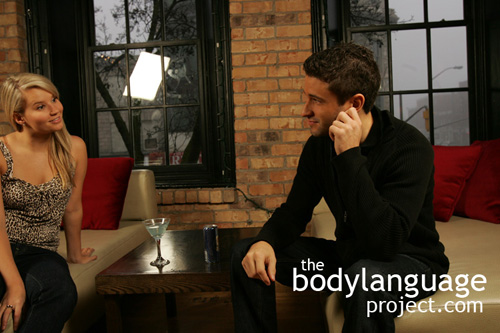
By keeping a “subject” relaxed, we can measure lying more accurately. Instead of creating lying-language through suspicion, we can find out which facts create discomfort – it is discomfort body language that helps uncover the truth.
Ex-FBI agent Joe Navarro explain in his book What everybody is saying that nonverbal cues put out by the limbic mind are paramount to detecting deception. He says that it is the displays of comfort versus discomfort that tells body language readers when someone is telling the truth or lying. When people lie they experience discomfort and “guilt knowledge” which leaks through the body through a person’s fear response, but when they tell the truth they “have no worries.” This approach says that a person uses more emphatic gestures with their hands and arms when they tell the truth, but when they lie they tend to freeze up and lock themselves down. If you see half-hazard attempts to describe events using lack of emphasis and gesturing, or in other words, remain uncommitted, than you can be pretty sure their story is fabricated. Truth tellers try their best to set facts straight and will go on at lengths to accomplish this.
The theory says that someone that is guilty carries negative thoughts with them because by nature, people are honest and think that they are good people. When they harbour bad thoughts though, they find it difficult to achieve comfort. The technique to reading lying as outlined states that a person must be read in low stress environments so that it is possible to measure changes from their baseline to catch stress related discomfort. Grilling someone for the truth has been show to produce “false positives”, meaning people who are actually innocent will actually plead guilty. Innocent suspects have been shown to confess to very serious crimes such as murder simply because they were put under very intense pressure. This is why it is important to establish comfort during all interactions, yet use appropriate questions to uncover the truth.
Overlooking someone suspiciously or presenting leading or accusatory questions will create discomfort, however it won’t show you which information presented leads to changes in nonverbal body language. It is by using relaxed and rapport building body language that allows someone to relax leaving only the information or question to be the variable by which all body language is measured. When scientists conduct research they do their best to keep all factors the same except for one. They call this the dependent variable, and it is by definition what is measured, or in other words what is affected during the experiment. The independent variable is what is manipulated in an experiment. When conducting a “lying experiment”, like all experiments, you want to keep all other variables constant so you can measure one variable against another variable.
Therefore, when we want to uncover lies, we should keep our body language neutral and remain calm while working to present information, details, asking for clarification, and so forth to uncover discomfort. This is why torture techniques don’t work to uncover the truth, they just pull information that the suspect believes the interviewer desires so they will stop badgering them. Just by using suspicious body language or leading questions can put someone on edge and influence their nonverbal communication. Saying things like “I don’t believe you” or “I think you are lying” will create anxious body language which can be misconstrued to be the result of actually being dishonest, when in actual fact is likely due to stress from being mislabeled. To body language reader will gain no useful information from creating anxiety. The rule of thumb therefore is to create and maintain comfort at all times, remain neutral in expression and measure signals of discomfort to uncover information that creates stress.


